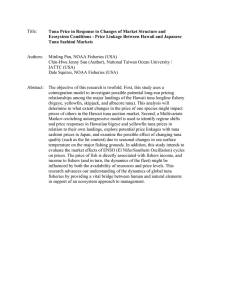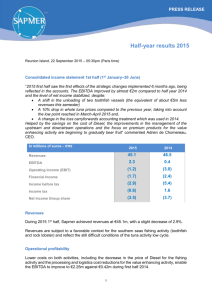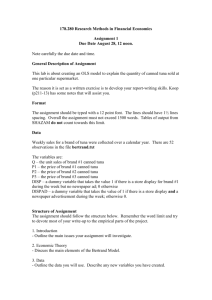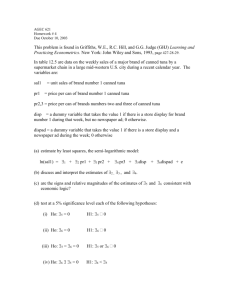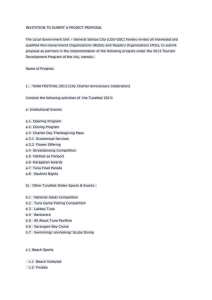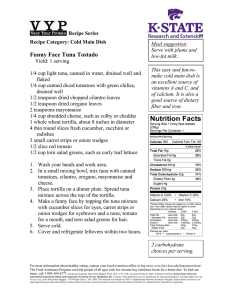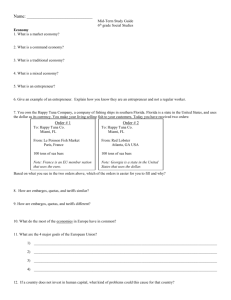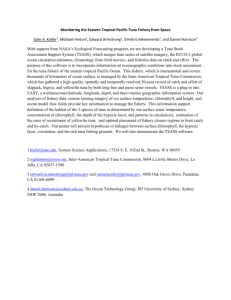THE VALUE CHAIN FOR PHILIPPINE TUNA COMMODITY: RECENT DEVELOPMENTS ABSTRACT
advertisement
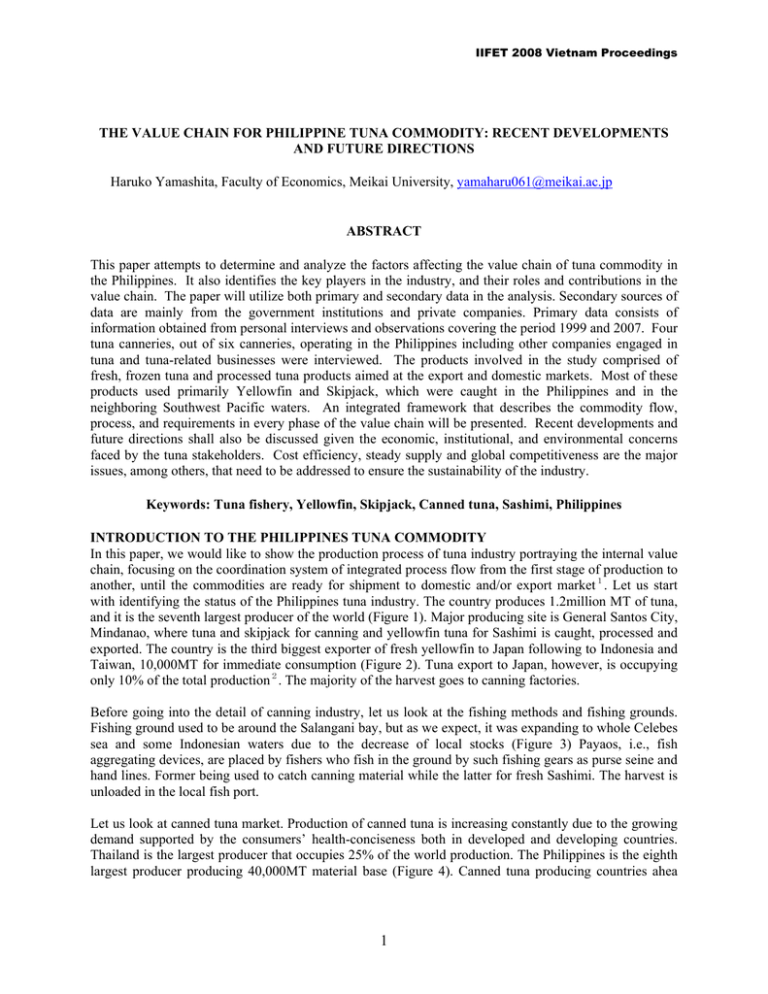
IIFET 2008 Vietnam Proceedings THE VALUE CHAIN FOR PHILIPPINE TUNA COMMODITY: RECENT DEVELOPMENTS AND FUTURE DIRECTIONS Haruko Yamashita, Faculty of Economics, Meikai University, yamaharu061@meikai.ac.jp ABSTRACT This paper attempts to determine and analyze the factors affecting the value chain of tuna commodity in the Philippines. It also identifies the key players in the industry, and their roles and contributions in the value chain. The paper will utilize both primary and secondary data in the analysis. Secondary sources of data are mainly from the government institutions and private companies. Primary data consists of information obtained from personal interviews and observations covering the period 1999 and 2007. Four tuna canneries, out of six canneries, operating in the Philippines including other companies engaged in tuna and tuna-related businesses were interviewed. The products involved in the study comprised of fresh, frozen tuna and processed tuna products aimed at the export and domestic markets. Most of these products used primarily Yellowfin and Skipjack, which were caught in the Philippines and in the neighboring Southwest Pacific waters. An integrated framework that describes the commodity flow, process, and requirements in every phase of the value chain will be presented. Recent developments and future directions shall also be discussed given the economic, institutional, and environmental concerns faced by the tuna stakeholders. Cost efficiency, steady supply and global competitiveness are the major issues, among others, that need to be addressed to ensure the sustainability of the industry. Keywords: Tuna fishery, Yellowfin, Skipjack, Canned tuna, Sashimi, Philippines INTRODUCTION TO THE PHILIPPINES TUNA COMMODITY In this paper, we would like to show the production process of tuna industry portraying the internal value chain, focusing on the coordination system of integrated process flow from the first stage of production to another, until the commodities are ready for shipment to domestic and/or export market1. Let us start with identifying the status of the Philippines tuna industry. The country produces 1.2million MT of tuna, and it is the seventh largest producer of the world (Figure 1). Major producing site is General Santos City, Mindanao, where tuna and skipjack for canning and yellowfin tuna for Sashimi is caught, processed and exported. The country is the third biggest exporter of fresh yellowfin to Japan following to Indonesia and Taiwan, 10,000MT for immediate consumption (Figure 2). Tuna export to Japan, however, is occupying only 10% of the total production2. The majority of the harvest goes to canning factories. Before going into the detail of canning industry, let us look at the fishing methods and fishing grounds. Fishing ground used to be around the Salangani bay, but as we expect, it was expanding to whole Celebes sea and some Indonesian waters due to the decrease of local stocks (Figure 3) Payaos, i.e., fish aggregating devices, are placed by fishers who fish in the ground by such fishing gears as purse seine and hand lines. Former being used to catch canning material while the latter for fresh Sashimi. The harvest is unloaded in the local fish port. Let us look at canned tuna market. Production of canned tuna is increasing constantly due to the growing demand supported by the consumers’ health-conciseness both in developed and developing countries. Thailand is the largest producer that occupies 25% of the world production. The Philippines is the eighth largest producer producing 40,000MT material base (Figure 4). Canned tuna producing countries ahea 1 IIFET 2008 Vietnam Proceedings Figure 2. Major Exporting Countires of Fresh Yellowfin Tuna to Japan(unit:1000MT) Figure 1. Volume of Tuna Production (unit:1000MT) 400 45 14 Japan 350 Taiwan 300 Indon esia 40 12 Taiwan 35 10 Indonesia Guam 30 250 Me xico Philippin es 8 25 6 20 200 Malaysia Spain Sin gapore 150 15 Philippin es 4 100 Microne sia 10 France 50 0 5 Total (righ t sc ale) 0 0 Ecuador 19 1 9 19 19 1 9 19 19 19 19 19 19 19 19 19 19 20 20 2 0 7 0 72 74 7 6 78 80 82 84 86 88 90 92 94 9 6 98 00 0 2 04 Australia 2 Kore a 19 88 19 90 19 92 19 94 19 96 19 98 20 00 20 02 20 04 20 06 source:FAO Fishstat note:Tunas include yellowfin, bigeye, albacore, bluefin and southern bluefin. No skipjack included source:FAO Fishstat Figure 3 Tuna Fishing Grounds and Unloading Sites around the Philippines Note: Philippines EEZ (dotted line) is an approximate reffering Aprieto (1995) p.13. Source: various sources Figure 5. Volume of Exort of Canned Tuna (unit: 1000MT) Figure 4. Volume of Production of Canned Tuna (unit:1000MT) 400 1600 120 1200 100 1000 80 800 60 600 40 400 20 200 USA 350 Spain 1400 Th ailand 300 1200 250 1000 Spain Ivory Coast Italy 200 800 150 600 Equado r Japan Ivory Coast Indo nesia Ec uador Indone sia Ph ilippin es 0 20 20 20 20 20 20 19 19 19 19 05 04 02 03 01 00 99 98 97 96 95 94 91 20 20 20 19 19 19 19 19 19 19 19 19 19 05 03 01 99 97 95 93 91 89 87 85 83 81 2 19 19 0 Th ailand (right sc ale ) 0 93 0 Total (righ t sc ale ) 19 Colu mbia Se ych elle s Se yc h elle s 92 200 19 400 50 19 100 Ph ilippines To tal (righ t sc ale ) IIFET 2008 Vietnam Proceedings the Philippines are, in the order of the volume of production, Thailand, USA, Spain, Italy, Japan, Ivory Coast, Ecuador and Indonesia. Among these countries, Philippine’s commodity is highly exported oriented3(Figure 5). Figure 6 draws a comprehensive picture of supply chain of skipjack and yellowfin tuna that landed at General Santos City where fish stock around Celebes Sea is utilized for both Sashimi and Canned tuna production. Catching vessels share to utilize payaos and both products are produced for export4. Tuna industry in the Philippines is composed of different types of companies (Figure 7). Some focuses on fishing and canning, an example of former being DTFI and the latter being Seatrade, while others try to do everything from catch in the sea to export. SAFRII is an example that even operates fish bidding market in General Santos port. Figure 6. Supply Chain of Yellowfin and Skipjack Landed at General Santos City Production Fishing Ground Species Fishing Methods Purse Seining Boat Juvenile Yellowfin and Skipjack Unloading Unloading and Bidding Bidding by Traders Canning Matured Yellowfin Domestic /Export Canned Tuna to Export Consumption Europe and North America Fertilizer and Animal Feed (by product) Sharing Payaos (FADs) Celebes Sea Exporting Processing Canning and Sashimi Handling Philippines Canned Tuna for Domestic Market A Handline Fishing by Pumpboat B Removeing Guts and Gills Shipping by Airplaine Japan Grading Cut Down to Fillet and Smaller Pieces Japan and USA C note: Solid lines denote export and dotted lines denote domestic distribution Source: From various sources Sashimi, Local Cuisine and Steak Local and Manila Figure 7. Variations in Business Activities of Major Tuna Companies in General Santos Sashimi Canning Company Catch Unloading Processing Exporting Catch Unloading Processing Exporting DTFI1 P escarich2 ○ MGTR3 ○ ○ R FM S W IFT 4 ○ ○ ○ ○ ○ ○ ○ ○ ○ ○ ○ Ocean SAFRII5 SMFI6 S eatrade Canning 7 ○ ○ ○ ○ ○ ○ ○ ○ ○ ○8 ○ ○ ○ ○ ○ ○ ○ Alliance Tuna General Tuna ○ ○ ○ ○ notes As of September 1999 and September 2007 1: Domingo Teng Fishing Industry. Fishing operation is also caried out by sister company TSP. Owner operates local department store 2: Japanese JV. Used to process CO treated fillet for export to US (1999), 3: Mommy Gina Tuna Resources 4: Former Rivera Fishing Management 5: San Andrew Fishing Resources and Industries. Owner operates bankin 6: St. Mary Fishing Industry 7: Sister company supplies 40-50% of tuna raw materials 8: Tin plates production is also integrated. source Aprieto(1995, p.86), Gladysingco-Evans(1995, p.13), Thomas(1999, pp. 167-169), and interviews. 3 Celebes Canning IIFET 2008 Vietnam Proceedings PRIMARY ACTIVITIES OF TUNA CANNING INDUSTRY Figure 8 is a well-known M. Porter’s notion of the value chain where profits are generated from the internal value chain, from both primary activities and support activities. We apply the theory to tuna canning industry by mapping in primary activities starting from inbound logistics operations 5 . The characteristics of inbound logistics are ownership and joint venture. Canning factories own or finance fishing boat so that they obtain canning material when it is needed. They also own cold storages so that they can meet fluctuation of supply and price. Since stock within the Philippine water is decreasing, some companies started joint ventures with Indonesia where the resource seemed to be still abundant6. The characteristics of operations are factory site and production method. All the tuna canneries except one locate factories in General Santos City where they have access to the material7. Some of them even moved their factories from metropolitan Manila to General Santos city leaving companies’ headquarters in Manila. Production method is labor intensive. Hundreds of workers work in three shifts per day so that the factory can operate 24 hours a day when they have enough supply of materials to meet demand. Most of workers in assembly line are woman of their age 18 to 40. The characteristic of marketing and sales is unique in many ways. First, most of the companies do not conduct intensive advertising. They rely more on personal selling basing on long-term relationship with clients. There are exceptions in marketing methods. One company displays at international trade fairs. Other company conducts a joint venture with a Thai company for marketing purpose; there are also some spot buying. Second, the product holds private labels of the companies abroad. Company names nor own brand names do not appear on the label; it is denoted merely as “Made in Philippines”. Third, there is a little competition in domestic market. Gen Tuna is the only company that distributes countrywide. Fourth, they meet the entire international requirement such as HACCP, Dolphin safe, Halal certification and Kosher certification. As to the services the industry receives from the public sector including government, DTI or Department of Trade and Industry provide such service as market matching. DOST or Department of Science and Technology support food processing technology meeting with hygiene and health. General Santos fish port was built in 1998 as a public port that improved fish landing and post harvest treatments8. Meeting of tuna related business and governmental body called Tuna Congress has been held annually in General Santos city at least up to 2008. It shows a unity and leadership of tuna business in the city that well attract the government’s attention. Figure 8 The Value Chain Firm infrastructure Human resource management Support Activities Margin Technology development Procurement Inboun d logistic s Operatio ns Outboun d logistics Marketin g and sales Service Primary Source: Michael E. Porter, Competitive Advantage. Creating and Sustaining Superior 4 Margi n IIFET 2008 Vietnam Proceedings Regarding cost structure of tuna canning industry, 60% of the cost is fish, 25-30% of the cost is can and the rest of 5-10% is labor according to Gen Tuna. These companies often support fishing gear in order to obtain necessary volume of raw material. The amount of financial support per trip is 250,000 – 300,000pesos (US$ 750,000) per fishing trip according to the same source. SUPPORT ACTIVITIES OF TUNA CANNING INDUSTRY The characteristics of the industry are also analyzed from its operation of support activities. Regarding firm infrastructure, the following characters are noted. The production method is labor intensive as we stated above, so that they invest minimum necessary amount of fund on machine. It works in such way that it can minimize fixed cost. At the same time, the production line maintains flexibility adjusting to meet the volume of production and quality of materials. Labor input can meet such variations. Let us take a look at human resource management. Factory workers, hundreds of them per factory, are employed for maximum five month. It is originally a custom to avoid insurance and befits burdens shouldered on employee if they hire longer than 5 months. With this custom hold, tuna companies start utilizing temporary employment agencies so that they can also avoid collective bargains that otherwise might attack normal operation. Some companies let agency operate canteen. Top managements, where the decision is mostly made, are highly educated stuff and sometime they are the group of relatives. Regarding Technology, canned tuna production method is an established technology and further innovation is not foreseen. In addition, input material is fixed as skipjack and yellowfin and there are a few variations in additional ingredients such as vegetable broth, oil, brine and water9. As to the variety of meet, it is again conventional within a limited variety such as solid, chunks or flakes. Variation in container can be noted as a trend of recent development. In addition to the conventional tin plate wrapped by paper label, easy open can, lithographic label and aluminum pouch is developed. In order to meet the customer demand of the material of container, one company started a joint venture with Thailand where all of theses materials can be produced. There are three channels where raw materials are supplied. One is from the own boat or independent fisher boat but the company finances operation. Second is the purchase from suppliers who sell both local and imported materials. The third is through joint venture with Indonesia where the resource is still abundant within their EEZ. So far, we have explained canned tuna production for export. However, there is a domestic market where 10% of the total production of canned tuna is absorbed. Gen Tuna is the de-facto monopoly of domestic market after acquiring fractions of companies. It is interesting that it conducts market segmentation within the company providing five different varieties with different brand names as follows. 1. Red Label 2. White Label 3. 555 (read as five five five) 4. Blue bay 5. Fresca There are many differences among these brands. Red Label and White Label are flat cans with gross weight of 180grams. Red Label contains limited variety of flavors such as vegetable broth, oil, brine and water. In other words, it is an export quality and targeting customers of high end. The price per piece is 28-30 pesos. White Label also contains high quality tuna but it adds local flavor. 555 and lower variety is sold in cylinder can with gross weight of less than 150. It adds local flavor such as Adobo and Afritada so 5 IIFET 2008 Vietnam Proceedings that consumers who are not familiar with tuna commodity would be tempted to buy and eat without making additional cooking. Flavor also works to mitigate smelling and color of meat for those lower qualities. The price of Fresca is 10-11 pesos, one third of that of the highest quality. RECENT DEVELOPMENT AND FUTURE DIRECTIONS In this paper, we shed light on the Philippines tuna commodity with particular focus on canned tuna product. Tuna canners are already aware of the decreasing supply of tuna due to over-fishing and global warming and high prices as a result. On the other hand there are increasing demand for canned tuna from the world. Tuna canning industry has a potential to expand its business. In order to make the prosperity last longer, sustainability and environmentally friendly fishing technology is a general concern both for the industry and the government. There are other subjects and concerns. As a closing, we will point out the issues starting with subjects; market expansion. Industry sector is ahead of the crisis by making joint ventures in fishing, canning and marketing activities with Thailand, Indonesia. One company mentioned about the feasibility of joint venture with Viet Nam. Some company also diversify product lineup into other seafood raw material for canning, e.g. baby clams, crabmeat. Variety in packaging is a future technological agenda. Expansion of markets, e.g. to China, Russia, etc. has to be considered. Since tuna is a new commodity for consumers in these markets, experiences developed in domestic market, such as starting with flavored tuna based on the local cuisine and segmenting markets by brands will be applied to the new market. Gen Tuna is trying to exploit Chinese market as a new frontier. It exports a class of white label tuna with Chinese flavor. The industry is trying to overcome difficulties. For example, import tariffs in Europe and US are higher than those preferred countries in Africa and South America. They try to lobby in order to reduce it to single digits. In addition, high transportation costs, also compared to rival exporters in Africa and South America is the obstacle for the export. Food safety and compliance with international standards are newly emerged subject that the industry will face in the future. REFERENCES Aprieto, Virginia. L.(1995)Philippine Tuna Fisheries, University of the Philippine Press. Thomas, F. Cedula (1999) The Commercial Fishery Sector of the Philippines, LDC Printers. Yamashita, Haruko (2008) Tuna Industry in Southeast Asia-Sustainability and Environmental Protection, Otorishobo (in Japanese (Tonan Ajiano Maguro Kanren Sangyo)). ENDNOTES 1 Preceding researches are made by Aprieto(1995) and Thomas(1999). Yamashita(2008) also discusses tuna value chain in Asia. 2 The statistics include frozen tuna that we do not discuss in this paper. Frozen tuna for Sashimi is caught in high seas by long line fishing gear without using Payaos. 3 The situation of Spain is unique in the sense that it increased the volume of production for export after the European market integration. It takes a role as if it is the “domestic” product within EU market. 6 IIFET 2008 Vietnam Proceedings 4 Matured yellowfin weighing over 20kg are utilized for Sashimi. Juvenile yellowfin and skipjack is utilized for tuna canning. 5 Observations are based on our interviews conducted in September 2007. We are indebted to these tuna canning companies in alphabetical order, Alliance Tuna, Gen Tuna, Ocean Tuna and Seatrade. Other two canning companies in the Philippines are Celebes Tuna and Filbest. 6 Indonesian government established a new policy in 2008 that bans an export of raw seafood material to overseas. Joint venture will work to keep supplying fresh or frozen fish caught in Indonesian water. 7 One exceptional company, Filbest, locates the factory in Zanboanga. 8 Prior to the construction of public fish port, four private fish ports were in operation. Those companies now hold fish bidding area within the fish port. 9 Albacore is the best quality material for canned tuna, but it is not normally caught in the Philippine water. ACKNOWLEDGEMENTS Research in 1998 was supported by JSPS Kagoshima-UP exchange program. Research including field research in 2007 and paper presentation in 2008 was supported by JSPS Kiban C 18580232. I am indebted to Dr. Evelyn Belleza, a co-presenter of IIFET 2008 for the support and advice. 7

